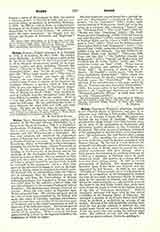

Weber BEDA, Benedictine professor, author, and member of the National German Parliament, b. at Lienz in the Tyrol, October 26, 1798; d. at Frankforton-the-Main, February 28, 1858. His father wished him to learn a trade as well as the ordinary work of a peasant, and thus Weber became a shoemaker. He was very talented, and completed the high-school course at Bozen in four years, and studied philosophy at Innsbruck during two years. He then entered the Benedictine Abbey of Marienberg in Obervintschgau, changing his Christian name, Johann Chrysanth, to Beda. In the autumn of 1821 he began to study theology at the University of Innsbruck, and on the abolition of the theological faculty there, he continued his course at Brixen. He was ordained in 1824, and went for a short time to the episcopal seminary at Trent to prepare himself for pastoral work; in 1825 he returned to his monastery. After a short time spent in the pastorate he began to teach at the high-school at Meran, where he remained for twenty years. He received calls to professorships from the University of Innsbruck, from the Benedictine lyceum at Augsburg, and from the Crown-Prince of Hohenzollern-Sigmaringen, but remained at Meran until he was called away by the political events of 1848. He was elected deputy to the national Parliament held at Frankfort. His parliamentary labors attracted attention. When the town priest of Frankfort died, Weber succeeded him. His activity and great zeal in the cure of souls was recognized by his bishop, who made him canon of Limburg, episcopal commissary, spiritual councillor, and member of the diocesan court at Frankfort and of the school commission, as well as inspector of the cathedral school. His labors proved too great for his frail constitution and he was soon carried off by apoplexy. Weber’s memory has been perpetuated by a fresco in the imperial cathedral, the restoration of which he began.
His chief works are: several poems for a poetical annual, the “Alpenblumen”, a translation of St. Chrysostom’s “On the Priesthood” (1833); studies upon Oswald treatise of Wolkenstein, which led to the discovery of a valuable MS. containing “Titurel” and the “Nibelungenlied”, “Das Land Tirol” (1837-8); “Meran and seine Umgebung” (1845); “Die Stadt Bozen and Hire Umgebung” (1849); “Das Tal Passeier and seine Bewohner” (1851), containing an account of Andreas Hofer and the events of 1809; “Erbhuldigung in Tirol” (1838); “Tirol and die Reformation in historischen Bildern and Fragmenten” (1841); “Lie-der aus Tirol” (1842), a selection of his poems; “Bluten heiliger Liebe and Andacht. Aus den Schriften der Giovanna Maria vom Kreuze”; “Giovanna della Croce and ihre Zeit”; “Die Gedichte Oswalds von Wolkenstein” (1847); “Oswald von Wolkenstein and Friedrich mit der leeren Tasche” (1850); and “Vormarzliche Lieder aus Tirol” (1850). Weber was an excellent preacher, and published “Predigten ans Tiroler Volk”, the proceeds of which he gave to charity. He founded a weekly paper, “Das Frankfurter katholische Kirchenblatt” (1853), which two years later became the Sunday supplement of a large Catholic paper, the “Deutschland”. He issued a selection of his contributions to this paper under the title of, “Cartons aus dem deutschen Kirchenleben” (1858); five years earlier he had collected his contributions to the “Augsburger Postzeitung” and to the “Historisch-politische Blatter” in book form under the title, “Charakterbilder”.
N. SCHEID

